Coccinellidae
Coccinellidae (/ˌkɒksɪˈnɛlɪˌdiː/)[3] is a widespread family of small beetles ranging in size from 0.8 to 18 mm (0.03–0.7 in).[4] They are commonly known as ladybugs in North America and ladybirds in Great Britain and other parts of the English-speaking world. They are however not true bugs. Many of the species have conspicuous aposematic colours and patterns, such as red with black spots, that warn potential predators that they are distasteful.
| Lady beetle Temporal range: | |
|---|---|
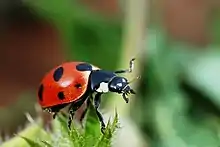 | |
| Coccinella magnifica | |
| Scientific classification | |
| Kingdom: | Animalia |
| Phylum: | Arthropoda |
| Class: | Insecta |
| Order: | Coleoptera |
| Suborder: | Polyphaga |
| Infraorder: | Cucujiformia |
| Superfamily: | Coccinelloidea |
| Family: | Coccinellidae Latreille, 1807 [1] |
| Subfamilies [1] | |
| |
| Synonyms | |
| |
The majority of the more than 6000 described species are generally considered beneficial insects, because many prey on herbivorous hemipterans such as aphids or scale insects, which are agricultural pests. Many coccinellids lay their eggs directly in aphid and scale insect colonies, ensuring their larvae have an immediate food source.[5] However, some species such as the herbivorous Mexican bean beetle are agricultural pests.
Etymology
The name coccinellids is derived from the Latin word coccineus meaning "scarlet".[6] The name ladybird originated in Britain where the insects became known as "Our Lady's bird" or the Lady beetle.[7][8] Mary (Our Lady) was often depicted wearing a red cloak in early paintings, and the spots of the seven-spot ladybird (the most common in Europe) were said to symbolise her seven joys and seven sorrows.[7][9] In the United States, the name was popularly adapted to ladybug. The names ladybird beetles or lady beetles have been proposed by the Entomological Society of America to avoid confusion with true bugs.[10] Common names in some other European languages share associations; for example, the German name Marienkäfer translates to Marybeetle.[11]
Description
Most coccinellids have round to elliptical, dome-shaped bodies with six short legs. Depending on the species, they can have spots, stripes, or no markings at all. Seven-spotted coccinellids are red or orange with three spots on each side and one in the middle; they have a black head with white patches on each side. Many coccinellid species are mostly or entirely, black, gray, or brown.
Coccinellids are often conspicuously coloured yellow, orange, or red with small black spots on their wing covers, with black legs, heads and antennae. There is, however, great variation in these colour patterns. For example, a minority of species, such as Vibidia duodecimguttata, a twelve-spotted species, have whitish spots on a brown background. Coccinellids are found worldwide, with over 6,000 species described.[12][4]
- Appearance of different species
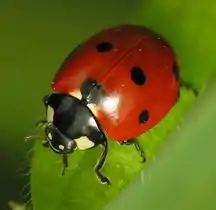 Coccinella septempunctata, black spots on red
Coccinella septempunctata, black spots on red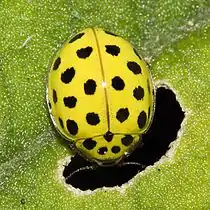 Psyllobora vigintiduopunctata, black spots on yellow
Psyllobora vigintiduopunctata, black spots on yellow.jpg.webp) Calvia quatuordecimguttata, whitish spots on brown
Calvia quatuordecimguttata, whitish spots on brown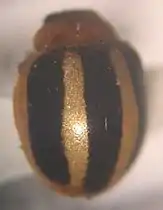 Brumoides suturalis, longitudinally striped
Brumoides suturalis, longitudinally striped Rhyzobius chrysomeloides, brown, unspotted
Rhyzobius chrysomeloides, brown, unspotted
Evolution
Fossil history
Although molecular clock estimates have placed their origin in the Cretaceous, the oldest fossils of the group are known from the Oise amber of France, dating to the Early Eocene (Ypresian) around 53 million years ago, which belong to the extant genera Rhyzobius and Nephus. They are diverse in the younger Eocene Baltic amber, including members of the extant genera Serangium and Rhyzobius as well as extinct genera belonging to the tribes Microweiseini and Sticholotidini.[13]
Phylogeny
The Coccinellidae are within the superfamily Coccinelloidea, which in turn is part of the infraorder Cucujiformia, a group containing most of the plant-eating beetles. The ladybirds form the majority of the species in the Coccinelloidea; many of the rest are small bark beetles. The Cleroidea, a superfamily of mainly hairy beetles with soft elytra, is the sister group to the Coccinelloidea.[14][15]
| Cucujiformia |
| |||||||||||||||||||||||||||||||||||||||||||||||||||
The internal phylogeny of the Coccinellidae has been studied using gene sampling across many species by LiHeng and colleagues in 2021. It identified three subfamilies including one newly-identified, the Monocoryninae. All three subfamilies were strongly supported, but the study noted that at lower level, while the tribes are mostly monophyletic, their relationships are only weakly supported. The study suggests that the crown group appeared some 143 Mya in the Early Cretaceous, and that the group diversified rapidly during the Late Cretaceous, perhaps because the growth in diversity of angiosperm plants then encouraged the radiation of Sternorrhyncha such as aphids on which ladybirds could feed.[16]
| Coccinellidae |
| ||||||||||||||||||||||||
Biology
Life cycle
Predatory ladybirds are usually found on plants which harbour their prey. They lay their eggs near their prey, to increase the likelihood the larvae will find the prey easily. In Harmonia axyridis, eggs hatch in three to four days from clutches numbering from a few to several dozen. Depending on resource availability, the larvae pass through four instars over 10–14 days, after which pupation occurs. After a teneral period of several days, the adults become reproductively active and are able to reproduce again later, although they may become reproductively quiescent if eclosing late in the season. Total life span is one to two years on average.[17]
Most species overwinter as adults in diapause, aggregating on the south sides of large objects such as trees or houses during the winter months, and dispersing in response to increasing day length in the spring.[18]
- Life cycle
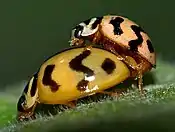 Adults mating
Adults mating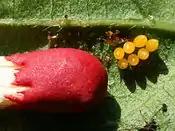 Eggs (match for scale)
Eggs (match for scale).jpg.webp)

Diet
Coccinellids are best known as predators of Sternorrhyncha such as aphids and scale insects, but the range of prey species that various Coccinellidae may attack is much wider. A genus of small black ladybirds, Stethorus, predates non-Sternorrhyncha; they specialise in mites as prey, notably Tetranychus spider mites. Stethorus species accordingly are important in biological control on many fruit crops.[19]
Several genera feed on various insects or their eggs; for example, Coleomegilla species are significant predators of the eggs and larvae of moths such as Spodoptera and the Plutellidae.[20] Larvae and eggs of ladybirds, either their own or of other species, can also be an important food resource when alternative prey are scarce. The Coccinellidae used to be regarded as purely carnivorous,[21] but they are far more omnivorous than previously thought, both as a family and in individual species; examination of gut contents of apparently specialist predators commonly yield residues of pollen and other plant materials. Most predatory coccinellids include other items in their diets, such as honeydew, pollen, plant sap, nectar, and fungi.[22]
- Diet
 Henosepilachna guttatopustulata, a herbivore, feeding on a potato leaf
Henosepilachna guttatopustulata, a herbivore, feeding on a potato leaf_with_Aphis_nerii.jpg.webp) Yellow-shouldered ladybird, Apolinus lividigaster eating an aphid
Yellow-shouldered ladybird, Apolinus lividigaster eating an aphid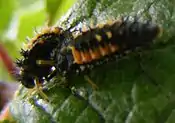 Harmonia axyridis larva cannibalism
Harmonia axyridis larva cannibalism
Certain species lay extra infertile trophic eggs with the fertile eggs, providing a backup food source for the larvae when they hatch. The ratio of infertile to fertile eggs increases with scarcity of food at the time of egg laying.[23]
Some species in the subfamily Epilachninae are herbivores.[24]
Ecology
The main predators of ladybirds are birds, but they are also the prey of frogs, wasps, spiders, and dragonflies. The bright aposematic colours of many coccinellids discourage potential predators, warning of their toxicity. Their haemolymph contains toxic alkaloids, most commonly polyazamacrolides and polyamines, as well as foul-smelling pyrazines. Some 50 types of alkaloid have been identified in ladybirds. When disturbed, ladybirds further defend themselves with reflex bleeding, exuding droplets of "blood" from their tibio-femoral (knee) joints, effectively presenting predators with a sample of their toxic and bitter body fluid.[25]
- Behaviour
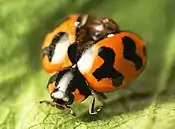 Coccinella transversalis, elytra in the open position
Coccinella transversalis, elytra in the open position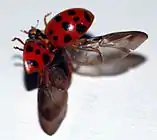 Full wings of a Harmonia axyridis taking flight
Full wings of a Harmonia axyridis taking flight
From 1990 to 2011, ladybirds in the British Isles declined by more than 20% due to environmental changes and competition from invasive species. The formerly common 10-spot and 14-spot ladybirds, along with 11-spot, 22-spot, cream-spot, water and hieroglyphic ladybirds, all declined. Conversely, harlequin, orange, pine, and 24-spot ladybirds, and Rhyzobius chrysomeloides increased.[26] The kidney spot ladybird was recorded in Scotland for the first time in recent years, and the 13-spot was found to have recolonised southern areas (Cornwall, Devon, and the New Forest). The most commonly recorded species was the 7-spot, closely followed by the Asian harlequin — an invader that arrived from continental Europe in 2003 after being introduced to control pests. An 'explosion' in the number of orange ladybirds, which feed on mildew, is thought to have been caused by warmer, damper conditions.[27]
Relationship to humans
Biological control
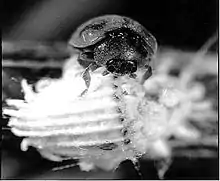
Ladybirds are natural predators of a range of serious pests, such as the European corn borer.[28]
The larva of the vedalia ladybird Rodolia cardinalis is a specialist predator on a few species of Monophlebidae, in particular the cottony cushion scale Icerya purchasi.[29] It was introduced to California in 1887 from Australia, to protect citrus trees from cottony cushion scale. The project was markedly successful, making it "a textbook example of the great potential of classical biological control as a tactic for suppressing invasive pests."[30] The vedalia beetle was then used in 29 countries, again with success. This led to many further attempts to use ladybird species against pests. Around 179 ladybird species were deliberately introduced to North America in the 20th century, of which only 18 became established. Further, establishment does not guarantee effective biological control of the target species. Thus, the vedalia beetle's success looks exceptional compared to the Coccinellidae as a whole; reasons for this include its high prey specificity, short generation time, efficient discovery of host patches, and larval development completed on a single host insect.[30]
Some species are voracious specialist predators, making them valuable as agents of biological control, at least when rapid impact is required, as with sudden outbreaks of aphids on crop plants. However, since many prey are transient or seasonal, high specificity and voracity can equally be a disadvantage. Ladybird species vary in specificity; those that are dominant in specific communities are often rather generalist in their diet. Species that are able to multiply quickly in response to aphid outbreaks are mostly generalists, enabling them to survive on other prey while aphids are scarce.[31] The variability of ladybird responses to prey has made finding suitable species for use as biological control agents difficult; out of 155 deliberate introductions meant to control aphids by the year 2000, only one was deemed to be "substantially successful".[32]
As an invasive species
Harmonia axyridis (the harlequin ladybird) was introduced into North America from Asia in 1979 to control aphids, but it is now the most common species, outcompeting many of the native species.[33] It has since spread to much of western Europe, reaching the UK in 2004.[33][34] It has become something of a domestic and agricultural pest in some regions, and gives cause for ecological concern. It has similarly arrived in South Africa, where it has proved variously unwelcome, perhaps most prominently in vine-related crops.[35]
Coccinella septempunctata, another introduced species in North America, similarly outcompetes and displaces native coccinellids.[36]
Infestations

In North America, coccinellids usually begin to appear indoors in the autumn when they leave their summer feeding sites in fields, forests, and yards and search out places to spend the winter. Typically, when temperatures warm to the mid-60s °F (around 18 °C) in the late afternoon, following a period of cooler weather, they swarm onto or into buildings illuminated by the sun. Swarms of the insects fly to buildings near fields or woods in September through November depending on weather conditions.[37] After an abnormally long period of hot, dry weather in the summer of 1976 in the UK, a marked increase in the aphid population was followed by a "plague" of ladybirds, with many reports of people being bitten as the supply of aphids dwindled.[38][39]
The presence of coccinellids in grape harvests can cause ladybird taint in wines produced from the grapes.[40]
In culture

Ladybirds have long been of interest to children. They once had many regional names in English, such as variations on Bishop-Barnaby (Norfolk and Suffolk dialect) – Barnabee, Burnabee, the Bishop-that-burneth, and bishy bishy barnabee.[41][42] The etymology is unclear, but it may be from St. Barnabas's feast in June, when the insect appears, or a corruption of "Bishop-that-burneth", from the fiery elytra of the beetles.[43] In the 17th century, they were sometimes named "ladycows".[43]
The ladybird was immortalised in the popular children's nursery rhyme Ladybird Ladybird:
Ladybird, ladybird, fly away home
Your house is on fire and your children are gone
All except one, and that's Little Anne
For she has crept under the warming pan.
This poem has its counterpart in German as Marienwürmchen, collected in Des Knaben Wunderhorn, and set to music by Robert Schumann as Op. 79, No. 13, and a Polish nursery rhyme, "Little Ladybirds' Anthem", of which a part ("fly to the sky, little ladybird, bring me a piece of bread") became a saying.[44]
In Christian areas, they are often associated with the Virgin Mary, and the name that the insect bears in the various languages of Europe corresponds to this. Although historically many European languages referenced Freyja, the fertility goddess of Norse mythology, in the names, the Virgin Mary has now largely supplanted her as the "Lady", so that, for example, freyjuhœna (Old Norse) and Frouehenge have been changed into marihøne in Norwegian and Marienkäfer in German.[45] Sometimes, the insect is referred to as belonging directly to God (Irish bóín Dé, Polish boża krówka, Russian божья коровка [bozhya korovka], all meaning 'God's [little] cow').[46] In Dutch it is called lieveheersbeestje, meaning 'little animal of our Good Lord'. In both Hebrew and Yiddish, it is called "Moshe Rabbenu's (i.e., Moses's) little cow" or "little horse", apparently an adaptation from Slavic languages. Occasionally, it is called "little Messiah".[47]
The insects have been used to symbolise Ladybird Books (part of Penguin Group),[48][49] and the Ladybird range of children's clothing sold by the former high street chain Woolworth's in the UK,[50] while the ladybird street tile is a symbol against senseless violence in the Netherlands, and is often placed on the sites of deadly crimes.[51] They have also been adopted as the mascot of Candanchú,[52] a ski resort near Canfranc in the Spanish Pyrenees. The ladybird also serves as a long-standing symbol for the Swedish People's Party of Finland.[53] Ladybirds have served as the US state insect of US states including Delaware.[54]
References
- "Coccinellidae Latreille, 1807". Integrated Taxonomic Information System. Retrieved 24 July 2012.
- "Wikispecies: Microweiseinae". 2012. Retrieved 9 March 2013.
- "coccinellid". The New Oxford Dictionary of English. Oxford: Clarendon Press. 1998. p. 351. ISBN 0-19-861263-X.
coccinellid /,kɒksɪ'nɛlɪd/ noun a beetle of a family (coccinelidae) that includes the ladybirds
- Seago, Ainsley E.; Giorgi, Jose Adriano; Li, Jiahui; Ślipiński, Adam (July 2011). "Phylogeny, classification and evolution of ladybird beetles (Coleoptera: Coccinellidae) based on simultaneous analysis of molecular and morphological data". Molecular Phylogenetics and Evolution. 60 (1): 137–151. doi:10.1016/j.ympev.2011.03.015. PMID 21426943.
- Society, National Geographic (10 September 2010). "Ladybugs, Ladybug Pictures, Ladybug Facts – National Geographic". Retrieved 4 October 2016.
- Brown, L., ed. (2007). The Shorter Oxford English Dictionary. Vol. 1 (6 ed.). p. 441.
- Anonymous. "Why are ladybirds so-called?". UK Ladybird survey. Archived from the original on 1 July 2018. Retrieved 15 October 2010.
- Samaha, John M. "Marian Roots of the Name". Our Lady's Bug. Dayton, Ohio: International Marian Research Institute. Archived from the original on 15 December 2012. Retrieved 15 October 2010.
- Roy, Helen E.; Brown, Peter M. J.; et al. (2013). Ladybirds (2nd ed.). Pelagic publishing. p. 142. ISBN 978-1907807077.
- Miller, Laura T.; Stange, Lionel; MacVean, Charles; Rey, Jorge R. (2008). "Ladybird Beetles (Coccinellidae: Coleoptera)". Encyclopedia of Entomology. Dordrecht: Springer Netherlands. pp. 2120–2131. doi:10.1007/978-1-4020-6359-6_1944.
- Anonymous. "common name: ladybirds, ladybird beetles, lady beetles, ladybugs (of Florida)". Featured creatures. University of Florida. Retrieved 8 April 2010.
- Judy Allen & Tudor Humphries (2000). Are You A Ladybug?, Kingfisher, p. 30
- Szawaryn, Karol (29 November 2021). "The first fossil Microweiseini (Coleoptera: Coccinellidae) from the Eocene of Europe and its significance for the reconstruction of the evolution of ladybird beetles". Zoological Journal of the Linnean Society. 193 (4): 1294–1309. doi:10.1093/zoolinnean/zlaa180. ISSN 0024-4082.
- Hunt, T.; Bergsten, J.; Levkanicova, Z.; et al. (2007). "A Comprehensive Phylogeny of Beetles Reveals the Evolutionary Origins of a Superradiation". Science. 318 (5858): 1913–1916. Bibcode:2007Sci...318.1913H. doi:10.1126/science.1146954. PMID 18096805. S2CID 19392955.
- Robertson, James A.; Ślipiński, Adam; Moulton, Matthew; et al. (2015). "Phylogeny and classification of Cucujoidea and the recognition of a new superfamily Coccinelloidea (Coleoptera: Cucujiformia)". Systematic Entomology. 40 (4): 745–778. doi:10.1111/syen.12138.
- LiHeng, Che (2021). "New insights into the phylogeny and evolution of lady beetles (Coleoptera: Coccinellidae) by extensive sampling of genes and species". Molecular Phylogenetics and Evolution (156): 107045. doi:10.1016/j.ympev.2020.107045.
- "What Is the Life Span of a Ladybug?". Sciencing. Retrieved 24 December 2017.
- Honěk, Alois; Martinková, Zdeňka; Pekár, Stano (3 January 2007). "Aggregation characteristics of three species of Coccinellidae (Coleoptera) at hibernation sites". European Journal of Entomology. 104 (1): 51–56. doi:10.14411/eje.2007.008.
- Hodek, Honěk & Van Emden 2012, p. 490.
- Roger, Caroline (1999). Mechanisms of prey selection in the ladybeetle Coleomegilla maculata lengi Timb. (Coleoptera: Coccinellidae) (Thesis). ISBN 0-612-50249-X.
- Smart, John (1963). British Museum (Natural History) Instructions for Collectors NO. 4A. Insects. London: Trustees of the British Museum.
- Almeida, Lúcia M.; Corrêa, Geovan H.; Giorgi, José A.; Grossi, Paschoal C. (September 2011). "New record of predatory ladybird beetle (Coleoptera, Coccinellidae) feeding on extrafloral nectaries". Revista Brasileira de Entomologia. 55 (3): 447–450. doi:10.1590/S0085-56262011005000028.
- Perry, Jennifer C.; Roitberg, Bernard D. (October 2005). "Ladybird mothers mitigate offspring starvation risk by laying trophic eggs". Behavioral Ecology and Sociobiology. 58 (6): 578–586. doi:10.1007/s00265-005-0947-1. S2CID 40491195.
- Li, C. S. (1 August 1993). "Review of the Australian Epilachninae (Coleoptera: Coccinelledae)". Australian Journal of Entomology. 32 (3): 209–224. doi:10.1111/j.1440-6055.1993.tb00577.x.
- Aslam, Muhammad Conspicuousness and toxicity of Coccinellidae: An aposematic review. Arthropods (PDF). 9 (3): 85–91 http://www.iaees.org/publications/journals/arthropods/articles/2020-9(3)/conspicuousness-and-toxicity-of-Coccinellidae.pdf.
{{cite journal}}: Missing or empty|title=(help) - Roy, Helen; Peter Brown; Robert Frost; Remy Poland (15 June 2011). Ladybirds (Coccinellidae) of Britain and Ireland. The Field Studies Council. p. 204. ISBN 978-1-906698-20-1.
- Sample, Ian (15 June 2011). "Spot check finds Britain's native ladybirds struggling to compete with alien invaders". The Guardian. p. 3.
- "European corn borer - Ostrinia nubilalis (Hubner)". entnemdept.ufl.edu. University of Florida.
- Sands, D. P. A.; Van Driesche, R. (July 1999). "Evaluating the host range of agents for Biological Control of Anthropods: Rationale, Methodology and Interpretation". In Van Driesche, R.; Heard, T.A.; McClay, A.; Reardon, R. (eds.). Proceedings of the X International symposium on Biological control of Weeds. pp. 69–83. hdl:102.100.100/205491.
- Hodek, Honěk & Van Emden 2012, p. 491.
- Hodek, Honěk & Van Emden 2012, pp. 489–490.
- Hodek, Honěk & Van Emden 2012, p. 492.
- Anon (5 October 2004). "'Deadly ladybird' sighted in UK". BBC News. Retrieved 17 June 2010.
- Anon. "The Harlequin Ladybird has landed!". The Harlequin ladybird survey. Archived from the original on 10 December 2012. Retrieved 17 June 2010.
- "Invasive Species South Africa - Protecting Biodiversity from Invasion - Harlequin ladybird citizen science project". Archived from the original on 24 December 2017. Retrieved 24 December 2017.
- Ramani, S.; Mohanraj, P.; Hm, Y. (2019). Indian Insects: Diversity and Science. CRC Press. p. 239. ISBN 978-0-429-59201-0.
- University of Kentucky-College of Agriculture Cooperative Extension Service
- Anonymous (5 July 2001). "Phew, what a scorcher!". The Northern Echo. Archived from the original on 4 July 2009. Retrieved 8 April 2010.
- Wainwright, Martin (17 May 2006). "The great drought". The Guardian. London. Retrieved 8 April 2010.
- Easton, Sally (2 February 2012). "Ladybird contamination on the rise". The Drinks Business. Union Press. Retrieved 21 June 2013.
- Timmins, Nicholas (14 October 1994). "The Tories in Bournemouth: Teachers promised support as Shephard calls truce". The Independent.
- Moor, Edward (1823). Suffolk Words and Phrases: Or, An Attempt to Collect the Lingual Localisms of that County. J. Loder. pp. 33–.
- Roache, Lewie C. (1960). "Ladybug, Ladybug: What's in a Name?". The Coleopterists Bulletin. 14 (1): 21–25. JSTOR 3999092.
- Szkolnastrona.pl. "szkolnastrona – Przedszkole Publiczne im. Jana Brzechwy w Małomicach – Nasze grupy – BIEDRONECZKI – 4 LATKI -".
- "Bishop Barnaby". Notes and Queries. 9. 29 December 1849.
- "dexonline".
- Born to Kvetch, Michael Wex, St. Martin's Press, New York, 2005, ISBN 0-312-30741-1.
- Gani, Aisha (12 October 2015). "Ladybird books introduce Peter and Jane to hipsters and hangovers" – via www.theguardian.com.
- "Ladybird". www.penguin.co.uk.
- Seaton, Paul. "Ladybird Clothing - a history of Pasolds". www.woolworthsmuseum.co.uk.
- Anonymous (April 2004). "Speech by Mrs Maud de Boer-Buquicchio on the occasion of the placement of a ladybird tile at the Council of Europe". Council of Europe. Retrieved 21 September 2011.
- www.staffmedia.com, StaffMedia Branding Design S.L. ->. "Estación de Esquí de Candanchú – Ven a esquiar en Familia". Retrieved 15 September 2016.
- IS: RKP uudisti ilmeensä - tässä on uusi logo (in Finnish)
- "TITLE 29 - CHAPTER 3. STATE SEAL, SONG AND SYMBOLS - Part . [REFER TO THE BOOK FOR THE PROPER TABLE]". delcode.delaware.gov.
Sources
External links
 Media related to Coccinellidae at Wikimedia Commons
Media related to Coccinellidae at Wikimedia Commons Data related to Coccinellidae at Wikispecies
Data related to Coccinellidae at Wikispecies